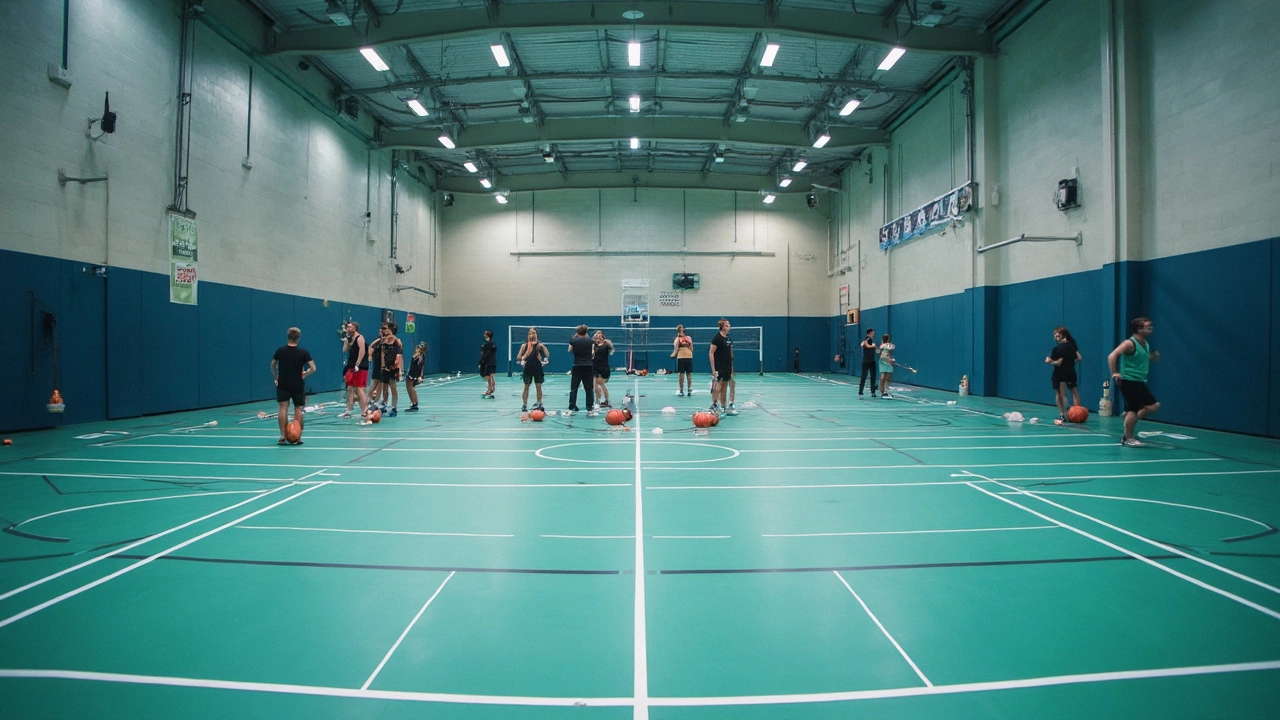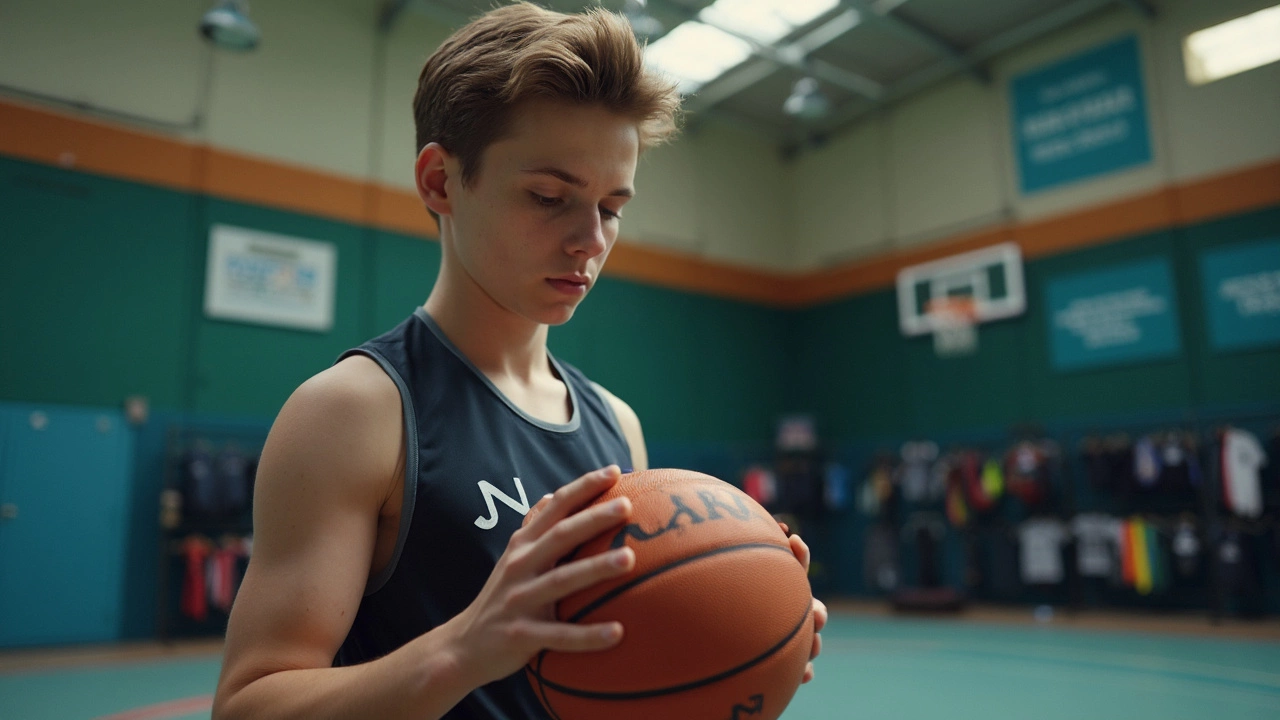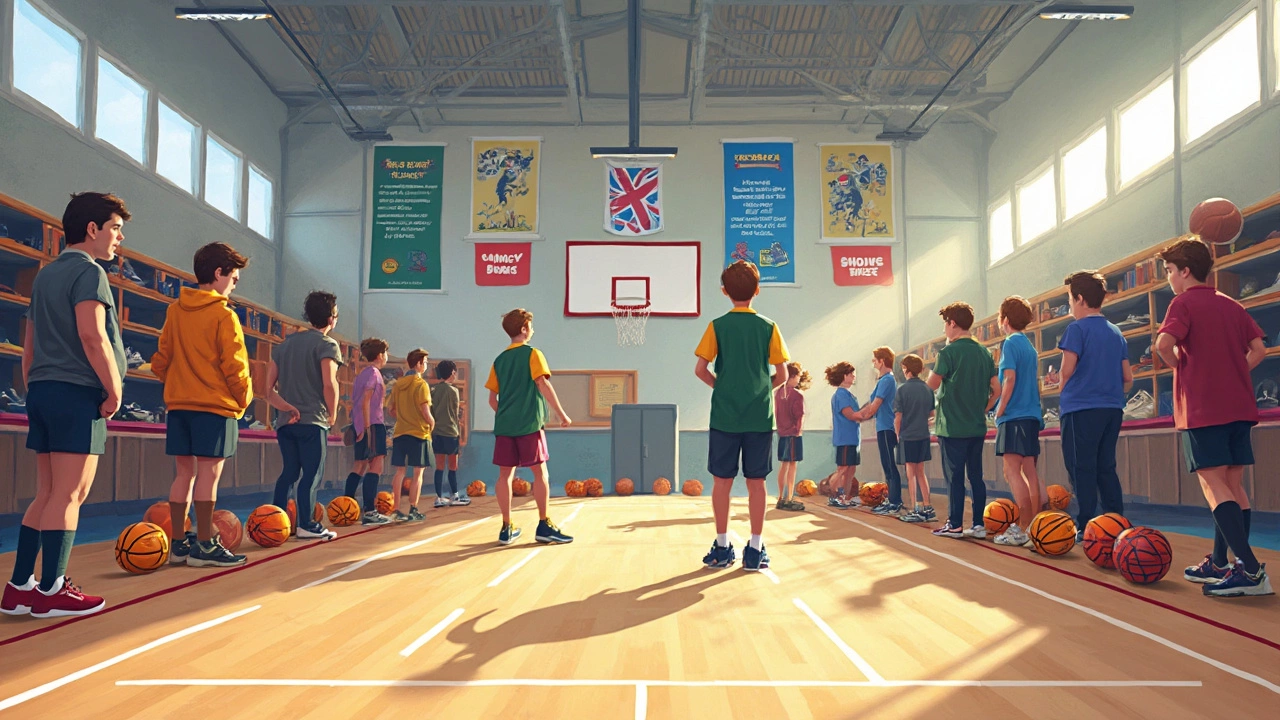Equipment and Facilities in Sports: What You Really Need to Know

Picture a soccer match with a flat ball or a basketball game without any lines on the court. It just wouldn't work, would it? In sports, equipment and facilities are the backbone. We're talking about everything athletes need, from the obvious stuff like rackets and goalposts, to the things you might overlook—think changing rooms, turf quality, or even locker ventilation.
If you're new to a sport, wrapping your head around what counts as 'equipment' and what counts as 'facility' can be weirdly tricky. Equipment usually means the things you put on or use actively—helmets, bats, balls, shoes. Facilities are the spaces built for play: stadiums, gyms, pools, skateparks. But there’s plenty of crossover too, like nets and scoreboards, which kind of sit in the middle.
Get the right setup, and you stay safe, play better, and actually enjoy yourself. Skimp on a good mouthguard or reliable shoes, and it's not just your performance that takes a hit—injuries are waiting to happen. A well-designed sports facility feels totally different too. It’s not just the fresh paint or shiny floors; it’s about decent lighting so you don’t trip, enough space for everyone, and equipment that actually holds up under pressure.
- Defining Equipment and Facilities in Sports
- Why the Right Gear Matters
- Different Types of Facilities Explained
- How Equipment and Facilities Affect Performance
- Tips for Choosing and Upgrading
Defining Equipment and Facilities in Sports
Let’s get the basics clear. When we talk about sports, equipment means the stuff athletes actually use for the game: think balls, bats, rackets, helmets, shoes, gloves, and protective pads. Facilities, on the other hand, are the actual places and structures where the action happens—fields, gymnasiums, swimming pools, running tracks, locker rooms, and even the lights and seating for spectators.
Here’s a quick breakdown:
- Equipment: Personal gear and objects used for play (like basketballs, cleats, and helmets).
- Facilities: Physical locations and built spaces for training or competition (stadiums, courts, training centers, gyms, etc.).
This might sound basic, but the difference does matter. For example, FIFA sets exact standards for soccer balls, field dimensions, and even goalpost sizes. It’s not just about making the game fair—it’s about safety and consistency worldwide. In the U.S., the National Federation of State High School Associations (NFHS) lists over 20 categories of equipment and facility rules for just high school sports alone.
One cool thing: even things like water bottle stations, electronic scoreboards, and dugouts count as part of your facility. And for equipment, it’s not always flashy; knee pads for volleyball players or the mesh bibs you throw over a shirt in practice all count.
"You can’t have safe, competitive, or fun sports without the right equipment and facilities. It’s about making sure every athlete, from kids to pros, gets the best chance to shine." — National Athletic Trainers’ Association (NATA)
| Type | Examples | Purpose |
|---|---|---|
| Equipment | Balls, helmets, shoes, rackets, bats | Enhance play, protect athletes |
| Facilities | Fields, courts, gyms, pools, locker rooms | Provide space and structure for play |
Getting these basics right affects everything, from regular practice to keeping injuries down. If you’re ever in doubt about gear or space, check your league or club’s guidelines—they’re usually strict for a reason. The right setup isn’t just good sense, it’s required by most sports authorities all over the world.
Why the Right Gear Matters
The difference between decent and great in sports often comes down to the gear you use. It’s not just about looking professional; real performance and safety depend on well-chosen equipment. Let’s be honest—nobody wants a twisted ankle from flimsy shoes or a cracked helmet when things get rough. There’s solid research showing that wearing the right gear dramatically lowers your risk for injuries. The American Academy of Pediatrics points out that, "Properly fitted safety equipment prevents thousands of sports injuries every year."
Here’s where most people go wrong: they grab the first cheap ball, outdated pads, or uncomfortable cleats they can find. Later, those choices come back to bite them—literally in some cases. Quality sports equipment may seem pricey at first, but it pays off in durability and peace of mind.
- Good shoes protect your joints from shock and prevent slips on the court or field.
- Mouthguards and helmets shield your teeth and brain—especially important for kids and teens.
- Grippy gloves and padded mats give you better control and balance, whatever the sport.
- Regulation-size balls and rackets make it easier to focus on practice, instead of wrestling with stuff that feels off.
Here’s a tip: Don’t just trust your eyes—always check for safety certifications or quality stamps. Look for gear recommended by the sport’s governing body, not just what’s on sale in the pop-up aisle at the grocery store. If you’re buying for your child, remember they outgrow things fast, but squeezing into too-small gear is never worth the risk.
The right stuff lets athletes focus on playing their best game, not worrying about blisters, sprains, or broken gear. Whether you’re buying shin guards for your kid’s first soccer game or finally upgrading your basketball, choose smart. Your body—and maybe your whole season—will thank you.

Different Types of Facilities Explained
Facilities come in all shapes and sizes, depending on the sport and how many people it serves. Each one has its job, whether it's giving athletes a safe place to play, changing the way a sport feels, or making sure games run smoothly. It's not just the big fancy stadiums you see on TV—there are way more types, and each has real specifics you should know about.
Here's a quick breakdown of some of the most common types of sports facilities:
- Sports fields and courts – This is your bread and butter: soccer fields, basketball courts, tennis courts, and tracks. Some fields are grass, others are artificial turf. Indoor courts usually use wood, while outdoor ones might use concrete, asphalt, or special synthetic surfaces.
- Pools – Competitive pools usually have precise dimensions (50 meters long for Olympic swimming) and use advanced filtration systems. Lane ropes, starting blocks, and anti-slip decking are key details, especially for safety.
- Gyms and fitness centers – These aren’t just for weightlifting. Good gyms have areas for cardio, stretching, and sometimes courts for sports like volleyball or even indoor cricket nets. Proper ventilation and flooring (think rubber mats) help prevent injuries.
- Stadiums – These larger-than-life spaces hold thousands of fans. Features like high-quality lighting, digital scoreboards, and sound systems matter for both players and audience. Stadiums also have seating, locker rooms, storage, and first aid rooms built in.
- Multi-purpose halls – Community centers, school gyms, and rec centers fit here. They might be set up for basketball today and futsal tomorrow. Movable seating and flexible courts help make these spaces useful year-round.
How important are the details? Huge. Even something as small as the height of a basketball rim (it’s exactly 10 feet) affects training and game play. For context, have a look at this data showing common facility measurements for popular sports:
| Sport | Facility Type | Official Size |
|---|---|---|
| Basketball | Court | 28m x 15m |
| Soccer | Field | 100-110m x 64-75m |
| Swimming | Pool (Olympic) | 50m x 25m |
| Tennis | Court (Singles) | 23.77m x 8.23m |
| Volleyball | Court | 18m x 9m |
Even if you’re not aiming for Olympic gold, knowing the basic requirements helps you spot when a space feels right—or if it might throw off your game. A solid sports equipment setup always goes hand in hand with a facility that fits the sport.
How Equipment and Facilities Affect Performance
The quality of your gear and where you play can totally change your abilities, no matter what sport you pick. This isn’t just about high-end brands or flashy arenas—sometimes, small improvements make the biggest difference. The ball’s grip, the field’s flatness, or even just working showers can all impact the outcome. Let’s look at what really matters.
Modern sports equipment is built for performance. A great example is in running: carbon-plated shoes have been linked to faster marathon records, with elite runners shaving off minutes thanks just to their trainers. In tennis, string tension affects control and power, while cutting-edge rackets let pros hit with more accuracy. Even helmets in football reduce concussion risk by up to 50% compared to older models, according to a 2022 sports safety study.
The space you’re in matters too. If the lighting is poor or the surface is uneven, injuries shoot up. Gyms with poor air flow feel stuffy and zap energy fast. Studies show that athletes in upgraded facilities with good lighting and ventilation are 20% less likely to report fatigue or muscle cramps.
Here’s a quick breakdown of how the right sports equipment and facilities move the needle:
- Safety: Proper gear prevents sprains, breaks, and head injuries.
- Performance Boost: Lightweight bats or shoes mean faster swings and quicker sprints.
- Endurance: Good surfaces and climate control let you play longer without wear and tear.
- Confidence: Playing with well-maintained equipment just feels way better, lowering anxiety for younger or newer athletes.
Here’s a side-by-side data look at performance outcomes with upgraded versus outdated gear/facilities:
| Factor | Upgraded Gear/Facility | Outdated Gear/Facility |
|---|---|---|
| Injury Rate | 5-7% per season | 15-20% per season |
| Missed Practices | Fewer than 3 per season | 6 or more per season |
| Average Game Performance (Points/Goals/Time) | +10 to 20% | -5 to 10% |
Bottom line? Don’t ignore the gear or where you play. Investing in better equipment and updating facilities isn’t just about comfort—it’s about real results on the scoreboard and fewer trips to the doctor.

Tips for Choosing and Upgrading
Picking the right gear and updating your setup can be confusing, but it’s less about the brand names and more about what actually fits your game. Whether you play soccer, basketball, or just hit the gym now and then, here’s a down-to-earth approach for getting what you need—and knowing when it’s time to swap something out.
- Sports equipment should always be tailored to your body type and skill level. For instance, a soccer ball comes in different sizes—kids under 12 use Size 4, while adults use Size 5. Basketball shoes should have grip and ankle support, especially if you play indoors on slick floors.
- Don’t ignore safety ratings. Look for helmets, pads, and mouthguards that meet your sport’s official standards. For example, football helmets in the US should meet NOCSAE certification. It’s not just about rules—it’s about preventing real injuries.
- Pay attention to wear and tear. Every piece of gear has an expected lifespan, and older equipment may not keep you safe. Replace running shoes every 300–500 miles; the foam breaks down, even if the outside still looks decent.
- Quality facilities matter more than glossy looks. Good lighting, proper flooring, and working ventilation are keys for safety and comfort. For any indoor sport, ventilation helps prevent heat and humidity issues, and slippery surfaces up the risk of injury.
- Whenever possible, try before you buy. Most decent sports shops will let you test rackets, gloves, or shoes. If you’re investing in home equipment like a treadmill, compare weight limits and motor warranties. Spending a bit more upfront can save you money (and headaches) long-term.
If you’re unsure how your current stuff stacks up, most coaches or experienced players are happy to give advice. You can also check out equipment guidelines from your sport’s governing body. For example, the NBA updates their basketball specs and rim heights every few years to keep things fair and safe.
Here’s a quick look at how often critical gear should be replaced or upgraded on average:
| Gear | Average Lifespan | Signs It's Time to Upgrade |
|---|---|---|
| Running Shoes | 300–500 miles | Worn treads, loss of cushioning, foot pain |
| Helmet (e.g. Football, Cycling) | Every 3–5 years or after impact | Cracks, dents, broken straps |
| Basketball | 1–2 years (frequent use) | Cracked surface, air leaks, loss of grip |
| Tennis Racket | 1–3 years (active players) | Worn grip, loose strings, frame cracks |
| Swimsuit | 4–6 months (frequent use) | Fading color, stretched fabric, lost elasticity |
Upgrading facilities can be a bigger deal, but even small touches help—repair peeling court lines, replace dim bulbs, and keep mats and gear clean. If you’re involved with a local club or school, see what grants or funding options are available for facility upgrades. Sometimes there’s unexpected support just waiting for someone to ask.
